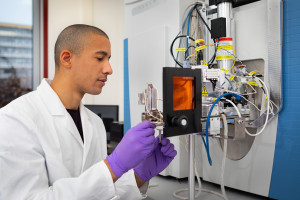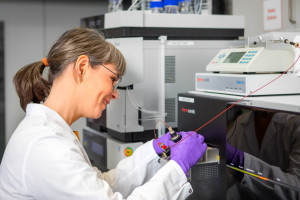-
The research programmes of ISAS pursue the development of various analytical methods to support cross-scale multi-parameter analysis in health research. The objective of this is to address the complex challenges in relation to analytics for personalised medicine (precision medicine).
The institute's four research programmes interlock with one another owing to the many scientific and technological questions. The synergies resulting from the interdisciplinary collaboration benefits the research projects within a programme. Combining complementary analytical methods plays a central role in the development of new multi-method concepts for health research. In this context the focus is always on the application-specific use of analytics.
-
The research programmes focus on: clarifying disease mechanisms and identifying possible treatment approaches – including application reference for subsequent pre-clinical research in both cases; identification and detection of diagnostic, prognostic and therapeutic markers; location- and time-resolved, ideally in-vivo representation of processes, from the molecular to the cellular level; non-invasive and non-destructive analysis methods.
Research Programmes
Publications
Journal of Proteome Research, Vol. 2025, 2025, P. 484-490
Lange E, Schallert K, Schwerdt J, Ghosh S, Hentschel A, Reinders Y, Heyer R.
The Omics Molecule Extractor: A Web Application for the Selection of Potential Biomarker Panels
https://doi.org/10.1021/acs.jproteome.5c00176
Proteomics. Clinical applications, Vol. 20, No. 1, 2025
Thilmany S, Thomas A, Reinders Y, Shakeri F, Vogel M, Sickmann A, Scholl C, Thevis M.
Hormonal Contraceptives and Depression: A Proteomic Analysis Using Neuronal Models
https://doi.org/10.1002/prca.70017
Coral Reefs, 2025
Stuhr M, Kollipara L, Reymond CE, de Beer D, Ries J, Sickmann A, Westphal H.
Differing proteome responses to ocean acidification between two common pocilloporid corals
https://doi.org/10.1007/s00338-025-02801-y
Cancer Discovery, Vol. 15, No. 12, 2025, P. 2437-2449
Yeh H, DelGaudio NL, Uygur B, Millet A, Khan A, Unlu G, Xiao M, Timson RC, Li C, Ozcan K, Smith KW, Nascentes Melo LM, Allies G, Basturk O, Sickmann…
Mitochondrial Glutathione Import Enables Breast Cancer Metastasis via Integrated Stress Response Signaling
https://doi.org/10.1158/2159-8290.CD-24-1556
Microbiome, Vol. 2025, No. 13, 2025
Tanca A, Schallert K, Grenga L, Peters SL, Abbondio M, De Diego L, Deledda MA, Haange S, Miotello G, Sáenz JS, Wolf M, Devos S, Hernandez-Raquet G,…
Critical Assessment of MetaProteome Investigation 2 (CAMPI-2): Multi-laboratory assessment of sample processing methods to stabilize fecal microbiome for functional analysis
https://doi.org/10.1186/s40168-025-02248-x
Angewandte Chemie - International Edition, Vol. 64, No. 46, 2025
Franz M, Das A, Chandola S, Kubicki M, Das M, Sette A, Corona D, Palummo M, Chiodo L, Schoeder R, Chahar P, Fuhrmann B, Engelhardt J, Düren O,…
N-Heterocyclic Carbenes on a III-V Semiconductor: From Chain Formation to Ordered Monolayers
https://doi.org/10.1002/anie.202511094
Npj imaging, Vol. 2025, No. 3, 2025
Pan Z, Sonneck J, Nagel D, Hasenberg A, Gunzer M, Shi Y, Chen J.
AutoQC-Bench: a diffusion model and benchmark for automatic quality control in high-throughput microscopy
https://doi.org/10.1038/s44303-025-00117-8
Nature computational science, Vol. 5, No. 11, 2025, P. 1041-1050
Dai G, Zhang R, Wuwu Q, Tseng C, Zhou Y, Wang S, Qian S, Lu M, Tuz AA, Gunzer M, Huang T, Chen J, Zhang S.
Implicit neural image field for biological microscopy image compression
https://doi.org/10.1038/s43588-025-00889-4



